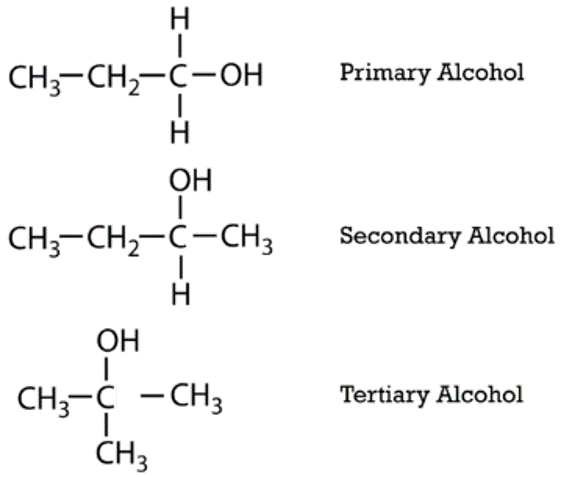Alcohols
An alcohol is an organic compound that contains one or more hydroxyl \(\left( \ce{-OH} \right)\) groups. The general formula for alcohols is \(\ce{R-OH}\). Do not confuse alcohols with inorganic bases that contain the hydroxide ion \(\left( \ce{OH^-} \right)\). The \(\ce{-OH}\) group in an alcohol is covalently bonded to a carbon atom and does not ionize in solution. The steps for naming alcohols are listed below.
- Name the parent compound by finding the longest continuous carbon atom chain that also contains the hydroxyl group. If there is one hydroxyl group in the molecule, change the final -e in the name of the alkane to -ol. If there is more than one hydroxyl group, use the full name of the alkane and add a suffix to indicate the number of hydroxyl groups. For example, two hydroxyl groups is -diol, three is -triol, etc.
- Number the carbon chain in a way that makes the sum of the hydroxyl numbers as low as possible.
- Add the numerical prefix into the name before the name of the alcohol.
- Separate numbers with commas and separate numbers from names or prefixes with a hyphen. There are no spaces in the name.
Following are three examples of alcohols and their IUPAC names.

Aliphatic alcohols can be classified according to the number of \(\ce{R}\) groups attached to the carbon with the hydroxyl group. If one \(\ce{R}\) group is attached to that carbon, the alcohol is a primary alcohol. If two \(\ce{R}\) groups are attached, the alcohol is a secondary alcohol. If three \(\ce{R}\) groups are attached, the alcohol is a tertiary alcohol. Shown below is an example of each. The primary alcohol is 1-propanol, the secondary alcohol is 2-butanol, and the tertiary alcohol is 2-methyl-2-propanol.

Properties of Alcohols
The smallest and lightest alcohols (methanol, ethanol, propanol) are completely soluble in water in all proportions. In a solution, the hydroxyl groups of alcohol molecules and the water molecules form hydrogen bonds with each other, resulting in complete miscibility. However, as the length of the carbon chain increases, the solubility decreases. The solubility of 1-butanol is \(7.4 \: \text{g}\) per \(100 \: \text{g}\) of water, while that of 1-pentanol is \(2.7 \: \text{g}\) per \(100 \: \text{g}\) of water, and 1-octanol is \(0.06 \: \text{g}\) per \(100 \: \text{g}\) of water. The carbon chain portion of the larger alcohol molecule is nonpolar, and leads to the decreased solubility of the overall compound.
The presence of hydrogen bonds in alcohols also explains the relatively high boiling points of alcohols compared to alkanes of similar molar mass (see table below).
| Compound |
Formula |
Molar Mass \(\left( \text{g/mol} \right)\) |
Boiling Point \(\left( ^\text{o} \text{C} \right)\) |
Table \(\PageIndex{1}\): Boiling Point Comparison of Alkanes and Alcohols
| ethane |
\(\ce{CH_3CH_3}\) |
32 |
-88 |
| methanol |
\(\ce{CH_3OH}\) |
30 |
64.7 |
| propane |
\(\ce{CH_3CH_2CH_3}\) |
44 |
-42.1 |
| ethanol |
\(\ce{CH_3CH_2OH}\) |
46 |
78.3 |
Only weak London dispersion forces hold molecules of nonpolar alkanes together in the liquid phase. Consequently, less energy is required to break these molecules away from the surface of the liquid and turn them into a vapor. The stronger hydrogen bonding between alcohol molecules means that more energy is required to convert the liquid to vapor, and boiling points are therefore high.



